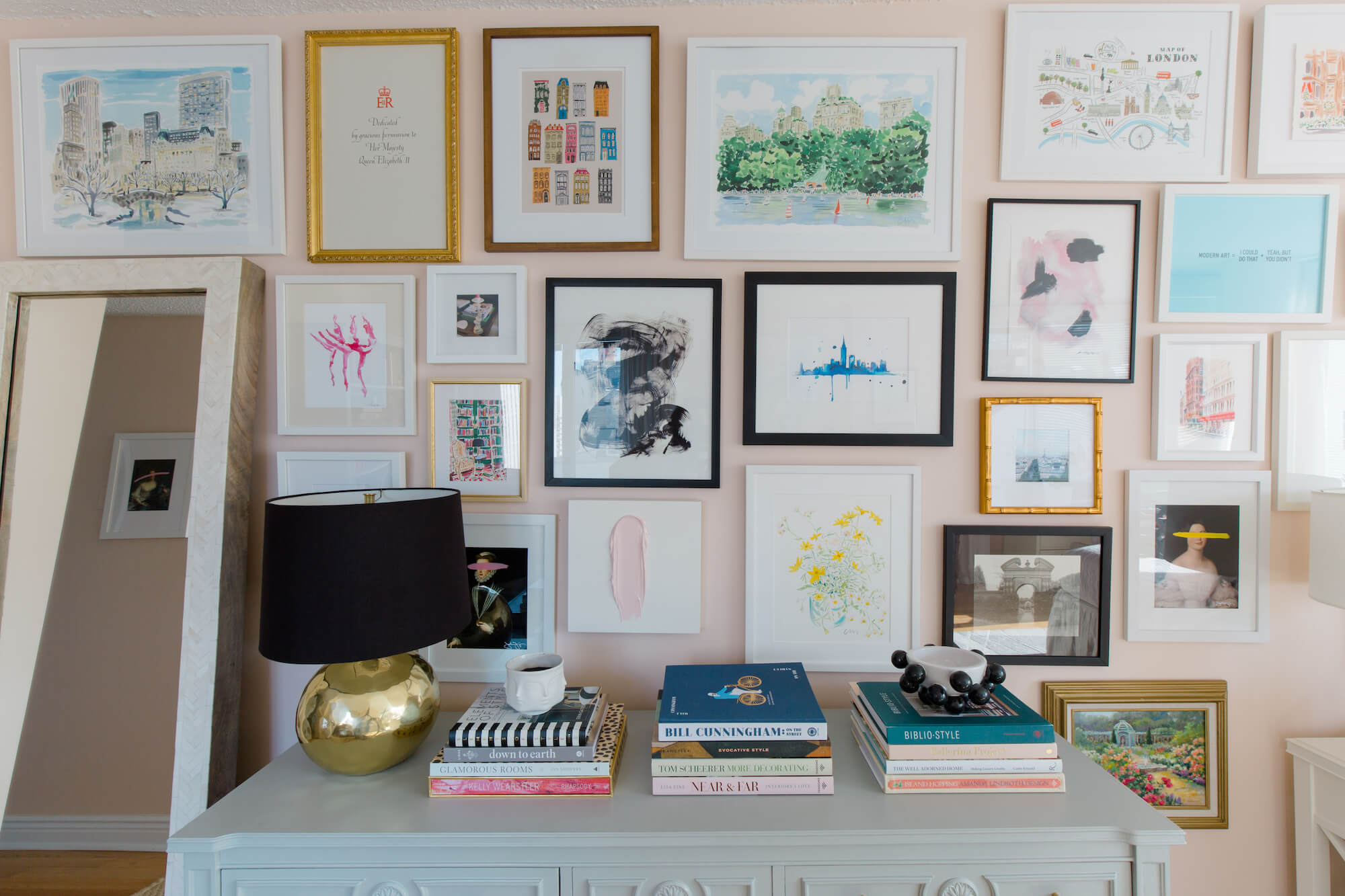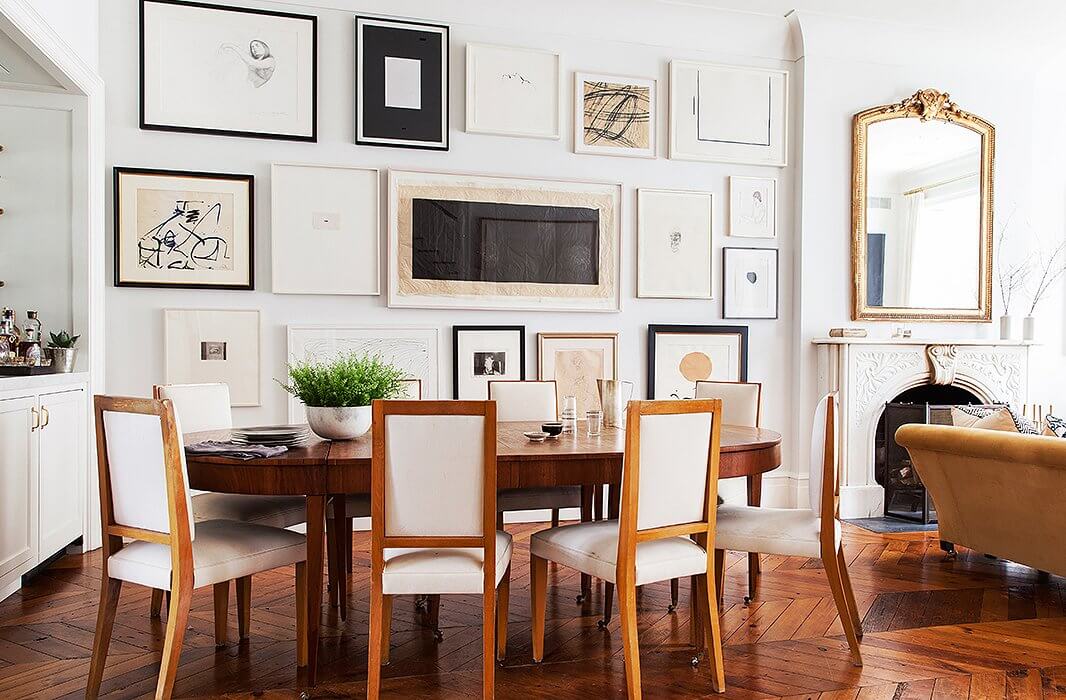
A while back I asked for gallery wall questions on Instagram and I’m finally answering them here. I hope this is helpful!
Framing Art for a Gallery Wall
How did you decide on frames?
To decide on frames for each piece, I really just look at the individual piece and think about what’s going to look best with it and allow it to really “shine.” For the most part, you usually can’t go wrong with a simple white wood frame, and probably 70% of the time that’s what I go with – but there are certain pieces where I think white wood just isn’t the best choice and so I’ll think about something different – an ornate gold frame, a brown wood frame, etc. Going to a professional framer is a great way to get more creative because they’ll be able to show you lots of different options. So yeah, generally just think about what’s going to show the art off in it’s best light, and when in doubt, keep it simple!
As far as mats go, I’m not a fan of colored mats or anything too complicated there – 90% of the time I think a plain white mat is the best choice. Again this is a great thing to talk about with a professional framer as they have ideas for creative matting if that’s something you want to try!
Where did you find all of your frames? That’s the hardest part for me!
I’ve found frames everywhere, from professional framing all the way down to Amazon. If you can swing it, professional framing can be a great option – but it’s not necessarily always worth it, and there are a lot of great DIY options. I’ve used Framebridge a lot. For inexpensive frames, try Pottery Barn Kids or PB Teen (hot tip – the same frames you can get at regular Pottery Barn are cheaper at Teen and Kids), CB2, the aforementioned Amazon, and West Elm. For a tip on how to customize a store bought frame, check out this old post of mine – it’s a great idea that still holds true! I’d also recommend checking out this post for tips on sourcing vintage frames.
Do you prefer plastic or glass covers in the frame?
Glass! Definitely glass. Preferably non-reflective glass, which is something you can get with a professional framer. It’s more expensive but it sure is nice to be able to really see the art without any reflection on it!

Finding Art
Where to find inexpensive art?
I wrote about that here! And to the person who asked and said they framed a postcard – I love that! I think framing unconventional and/or meaningful items like a photo booth strip, a postcard from a fun trip, a piece of fabric you like, etc, is a great and inexpensive way to create unique art.
Arranging and Hanging a Gallery Wall
How start/plan one? Rules for mixing/matching?
I wrote a post on this very topic here but I’ll talk about it below too!
The first step to starting a gallery wall is to collect and frame art! Gather up a good selection of pieces that you love and try not to do it all at once – things are always best and most natural when they’re slowly collected over time. So keep your eyes open as you scroll Instagram – there are so many artists on there and it’s a great place to find new sources for art. Check out vintage/thrift/antique shops if you can (both online and in person) for vintage art and frames. Keep in mind that you can find a great piece with an ugly frame or vice versa, and the art can be reframed or the art can be removed so you can use the frame. There’s so much great art out there and the key is just finding it! Once you have all of your art, check out this post of mine for how to plan and hang a gallery wall.
When it comes to rules for mixing and matching, as far as I’m concerned, there are no rules. I love an eclectic gallery wall and that’s what I have currently. All different types of art are mixed with all different types of frames, and that mix makes me so happy. Others may prefer a more curated and cohesive gallery wall. To do that, you can use different art but frame it all the same, or you can look for art that’s in the same color palette (all black and whites for instance, or all neutrals), or you can do a loose “theme” like a coastal vibe with blue watercolors and beach scenes. I would just be careful with a theme because it can go cheesy and tacky very quickly, but done carefully and subtly it can be really nice. You can do a gallery wall that’s all watercolors, or all photographs. The options really are endless and it’s all about what appeals to you personally!
How do you arrange/hang them and what do you do if you want to add a new piece?
To arrange a gallery wall, I make paper cut-outs of each piece and arrange them like a puzzle, which I describe in detail here. I think this is the best method and highly recommend it!
If I want to add a new piece, I’ve usually just done some light rearranging to get it to fit in cohesively. There have been times where I did a gallery wall and naturally there was space left on a corner or edge where a new piece could fit, which is always good. Other times I’ve had to rearrange and rework it a bit to get a new piece to fit in.
Did you hang it up all at once or slowly add individual pieces?
For my current gallery wall, I already had so much art that I was able to hang it up all at once (for the most part). There were some holes which I slowly filled with new pieces as they came. If you only have a few pieces, I say get started and add to it as time goes on. No time like the present!
How do you pick cohesive pieces/What do you do to make it so cohesive?
These kind of make me chuckle because as far as I can tell, my gallery wall isn’t cohesive at all! Haha. As I mentioned above, I love an eclectic mix so I don’t worry about picking cohesive pieces – I just get what I love. I guess maybe they seem cohesive because they’re all my taste and so there’s a consistent thread there – and that’s a great thing that will happen when you pick things you love! But I have a mix of originals and prints, photographs, watercolors, illustrations, drawings, abstracts, vintage, new, black and white, colorful art, a canvas, etc…a little of everything!

This is a fantastic example of a cohesive (but not boring!) gallery wall. All of the art has a similar vibe – neutral, modern, mostly black and white. All of the frames are thin and black, white, or gold. Most of the pieces have a lot of negative space, either in the art itself or through a large mat.
Did you have all the photos framed and chosen before you started hanging them?
For the most part for my current gallery wall, yes – only because I’ve been “collecting” art for such a long time that I have a ton of it! I did have some space to add new things though, which always makes me happy because that way I feel like there’s still room to grow.
Did you just start hanging and arranged them on the wall as you hung them?
For my current gallery wall, yes – I just started in one corner and kept hanging and stepping back to evaluate as I went. For my previous gallery wall, I used the cutout technique I described here (and that’s what I recommend doing!).
How do you hang frames so they line up perfectly?
This question could mean a few different things, but one of the things I like about gallery walls (versus something like three frames lined up or a grid gallery wall), is that the frames don’t have to line up perfectly! If you’re hanging frames all in a row they have to be so perfectly aligned and you might even have to do math (uch) whereas with gallery walls, it’s all more loose and imperfect. If you’re asking about hanging frames straight, a level is always a helpful tool for that. If you’re asking about getting the spacing right between frames in a gallery wall, that’s definitely a good question because it’s probably one of the most challenging things about doing a gallery wall. You want to make sure they’re all spaced relatively evenly (as much as that’s possible), and that it all kind of hangs together cohesively, but still looks kind of casual and not too perfect. The way I achieve the right spacing is by using the technique I describe in this post, which allows me to experiment and move things around until it looks right before I commit to making any holes in the wall. It’s just a matter of moving things around, kind of like puzzle pieces, until the spacing is relatively even and it all looks right to your eye.
Supplies needed to pull it together?
Framed art, hammer and picture hangers (or Command strips), pencil, ruler, and paper cutouts – all described and detailed here with a step-by-step guide!

“Rules” For Gallery Walls
Is it ok to have 2 gallery walls next to each other (1 in kitchen wall and the other in living room?)
Yes, absolutely! The only thing I would advise is that they have some sort of separation or demarcation between them – like are they in different rooms, is there some type of architectural feature between them? If not it’s kind of like, why aren’t they just one gallery wall? But if there’s a separation of some sort then by all means, feel free to have 2 in close proximity.
What inspires you?
I’m constantly inspired by gallery walls I see out there – through Pinterest, blogs, magazines, home tours, and on Instagram.
Should gallery walls go all the way to the ceiling?
Not necessarily! My current one does because I was going for a floor to ceiling wallpaper look, but generally they should be hung in a way that makes sense with the piece of furniture they’re hanging above, and then it can work it’s way up if need be.
How do often do you dust it?
This made me laugh too – not enough! I’ll definitely concede that that’s one of the annoying things about gallery walls (or any object really!), constant dust! I try to do once a week.
Thanks for all of the great questions! If you have art hanging around in a closet or on the floor waiting to be hung, I hope this inspires you to create something beautiful in your home that will make you happy whenever you look at it!
More on gallery walls – a tour of my gallery wall + full source list, step-by-step tips for creating a gallery wall, my old gallery wall



I’m amazed by the intricacies and details described in your post but all of the effort has certainly paid off. Your gallery wall is neat, orderly, beautiful and creates, from my perspective, a sense of joy and calm.
Thank you so much! It definitely takes some effort but it’s worth it!
Great post. Thanks for all the info!!
You’re welcome!
My exact question answered! Thanks!
So glad it was helpful!